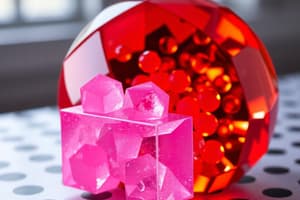Podcast
Questions and Answers
Why are the densities of the solid and liquid forms of a substance different?
Why are the densities of the solid and liquid forms of a substance different?
- The particles in the solid have a different shape than in the liquid.
- The particles in the solid are slightly closer together than in the liquid. (correct)
- The particles in the solid have a different mass than in the liquid.
- The particles in the solid are further apart than in the liquid.
What is the volume of 2000 kg of solid copper?
What is the volume of 2000 kg of solid copper?
- 8020 m³
- 0.223 m³ (correct)
- 0.249 m³
- 8960 m³
What is the volume of 2000 kg of liquid copper?
What is the volume of 2000 kg of liquid copper?
- 8960 m³
- 0.223 m³
- 8020 m³
- 0.249 m³ (correct)
What is the change in volume when 2000 kg of copper is melted?
What is the change in volume when 2000 kg of copper is melted?
What is the density of solid copper?
What is the density of solid copper?
What is the density of the iron girder?
What is the density of the iron girder?
What is the volume of the iron girder?
What is the volume of the iron girder?
What is the density of solid copper?
What is the density of solid copper?
What is the mass of the 0.5 m^3 delivery of copper?
What is the mass of the 0.5 m^3 delivery of copper?
What is the formula used to calculate density?
What is the formula used to calculate density?
What is the first step to measure the density of a liquid?
What is the first step to measure the density of a liquid?
In measuring the density of a solid, what is used to calculate the volume of the solid?
In measuring the density of a solid, what is used to calculate the volume of the solid?
How is the density of a solid calculated?
How is the density of a solid calculated?
If an object floats in water when measuring density, what should be done?
If an object floats in water when measuring density, what should be done?
What is crucial to know in order to calculate density?
What is crucial to know in order to calculate density?
What type of changes are changes of state?
What type of changes are changes of state?
How is density defined?
How is density defined?
In general, when is a substance more dense?
In general, when is a substance more dense?
What are the units for expressing density?
What are the units for expressing density?
Which formula represents density correctly?
Which formula represents density correctly?
Which state of matter can be compressed?
Which state of matter can be compressed?
Why can't solids be compressed?
Why can't solids be compressed?
Which process involves a substance changing from a solid directly to a gas?
Which process involves a substance changing from a solid directly to a gas?
What is the process called when a liquid changes to a solid?
What is the process called when a liquid changes to a solid?
Which process involves a gas changing directly to a solid?
Which process involves a gas changing directly to a solid?
Study Notes
Densities of Solids and Liquids
- The density of a solid is higher than that of a liquid because the particles are closer together in a solid.
- The mass of a substance per unit volume is higher in a solid than in a liquid.
Calculating Density
- Density = Mass / Volume
- Units: Mass (kg), Volume (m³), Density (kg/m³)
- Example: Calculating the density of an iron girder: Density = 7074 kg / 0.9 m³ = 7860 kg/m³
- Example: Calculating the mass of a delivery of copper: Mass = Density x Volume = 8960 kg/m³ x 0.5 m³ = 4480 kg
Measuring Density
- Method for measuring density of a liquid:
- Place a measuring cylinder on a balance and pour in the liquid
- Use the volume in the measuring cylinder and the mass on the balance to calculate density
- Method for measuring density of a solid:
- Place a solid on a balance to measure its mass
- Fill a displacement can with water and place a measuring cylinder under the spout
- Add the solid into the water, the water displaced is the volume of the solid
- Calculate the density
Changes of State
- Changes of state are physical changes because no new substances are formed (the particle arrangement just changes)
- Types of changes of state:
- Sublimation
- Melting
- Boiling
- Freezing
- Condensing
- Deposition
Properties of Solids, Liquids, and Gases
- Solids cannot be compressed because there are no gaps between the particles
- Liquids are similar to solids and cannot be compressed
- Gases can be compressed because there are lots of space between the particles
Studying That Suits You
Use AI to generate personalized quizzes and flashcards to suit your learning preferences.
Description
This quiz covers the explanation of why densities of solid and liquid substances differ, and calculates the change in volume when 2000 kg of copper is melted. Understand the relationship between particle arrangement and density, and practice volume calculations for phase changes.




